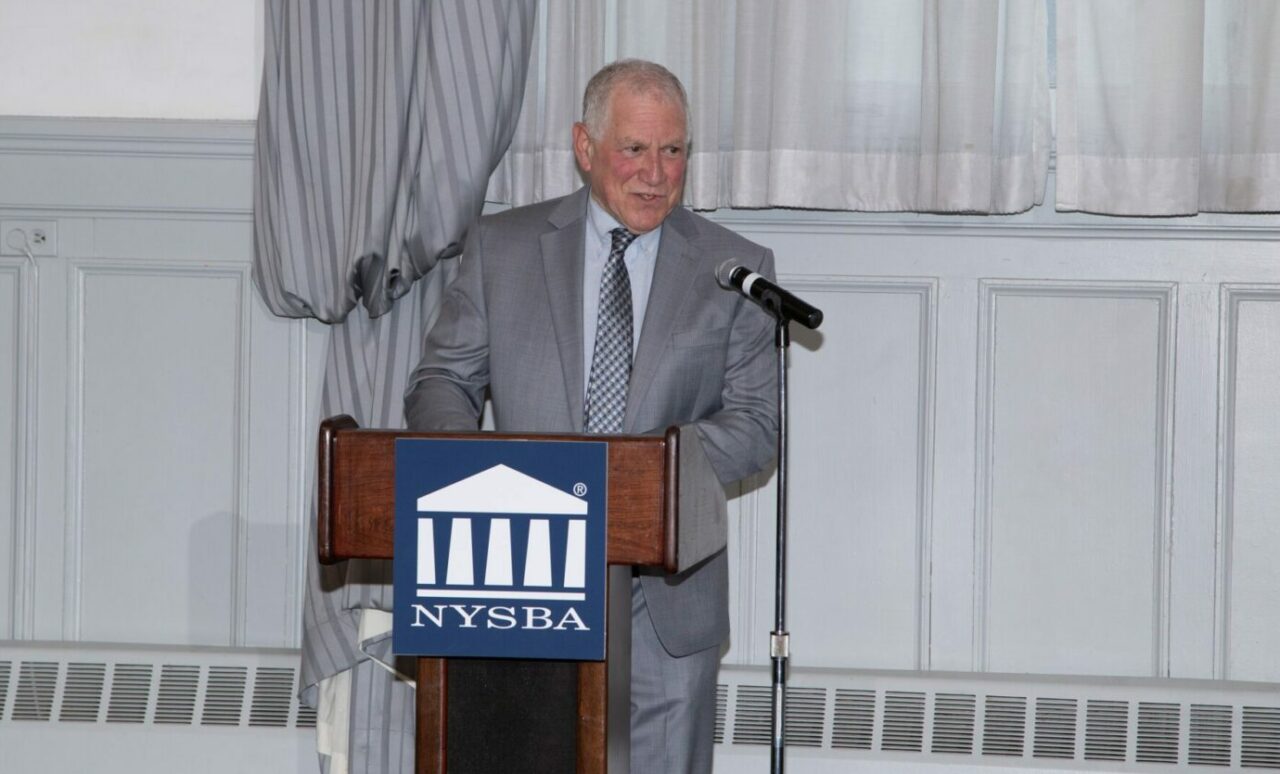COVID-19 and Its Lasting Impact on the Legal Profession
10.13.2021
COVID-19 and its delta variant have created ever-changing workplace scenarios for lawyers and law firms. Should we go hybrid? If so, how will that work in practice? Should we continue to be mostly remote? How will we replicate the collaboration and cooperation of the 2019 workplace under new workplace guidelines?
Amid all this flux and uncertainty, law firms responded quickly and efficiently. The 2020 move-out was almost instantaneous. Technology, which has moved slowly into law firms, exploded as firms added security features, upgraded computers and monitors, reinforced cybersecurity for home use, linked mobile apps to office databases and added videoconferencing technology, plus all the lights and cameras needed to participate effectively in meetings online.
To understand where we are now and where we are going, NYSBA appointed a task force on the future of the legal profession. The task force is sending out a survey to find out what you, in the trenches, think about the future for lawyers and law firms and is gathering information at public forums held by its four working groups. The association is also delving into this topic in this edition of the Bar Journal. For this article, I conducted electronic interviews with 23 New York lawyers; six are solos and the rest are in small to mid-size firms, ranging from two to 100 lawyers. Their geographic reach is fairly evenly divided into thirds: one-third covering New York City, one-third regional/New York State, and one-third either national or international in scope. All major practice areas are represented.
Most firms found that remote work did not impact productivity, although those unable to create a separate office space faced greater challenges. Similarly, most felt that client service levels did not decline. But many have missed the collaborative and collegial aspects of in office activity.
These lawyer respondents are optimistic about the future and proud of their responses to the pandemic. The lawyers felt that their firms did well in 2020 in terms of both clients and revenue, and very well in 2021. Only 16% reported fewer clients in 2020; 35% reported revenue decreases in 2020. With most of the firms seeing growth even in the worst of COVID times, it is not surprising that 85% are optimistic about growth in 2022. The management challenges during this period were diverse, ranging from managing a digital transformation to supporting the culture and retaining talent.
Firm Culture
Firm culture is an especially important aspect of ensuring continued high-quality client service in the face of the pandemic. Culture and attitude determine whether a firm can manage this roller coaster or whether it will manage them.
According to Joel Weiss, managing partner of the intellectual property boutique Weiss & Arons: “The 2020-21 pandemic year challenged our firm to remain relevant and vital in the new world order. Every firm is being challenged on some level to reconstruct itself to deal with what seems to be a new distributed model. Throughout the pandemic, our emphasis has been safety first. This will continue as the unwritten portions of the pandemic develop.”
Amy Goldsmith, partner and chair of the privacy/cybersecurity group at Tartar Krinsky & Drogin, stresses the importance of lawyers’ attitudes: “The most important impact felt by Tarter Krinsky & Drogin as a result of the pandemic is not defined by a singular word but by several: adaptability, resilience and teamwork.”
Nancy Schess, partner at the management-side employment boutique firm, Klein Zelman Rothermel Jacobs & Schess, similarly focuses on attitude: “We have all learned the importance of both flexibility and a sense of humor in running a law practice. The pandemic kept proving, and is still proving, that plans get disrupted. Consistent with our firm’s culture, we make a conscious effort to pivot as necessary and keep our attitudes intact.”
On a less positive note, Mark Mulholland, partner at Ruskin Moscou Faltischek, notes that “the lack of physical presence in the office, particularly among senior attorneys, and the corresponding fall-off in mentoring and spontaneous collaboration.”
Location, Location, Location
Firms have been embracing the office return slowly as vaccination mandates and news about increasing hospitalizations make togetherness sound more hazardous. The issue is still not resolved in many businesses. A “Smart Brief on Your Career” September poll of readers of the SmartBrief website showed that 52% said their office reopening decision was still in flux, 22% said their opening had been postponed and 22% said they were fully open in person.
As Tracey Daniels, principal at Daniels O’Connell, a real estate boutique, explains, “Real estate closings were happening in person even at the height of the pandemic, so we were in person, as needed, all along. That said, when we didn’t need to be in, we were all home as it was of topmost importance that our employees felt and were safe.”
George Kontogiannis, trust and estates partner at Tesser, Ryan and Rochman, describes his firm’s evolutionary process: “Initially with the unknowns of this new pandemic, we mandated 100% remote working. By July 2020, we started relaxing our protocols, first having just a few attorneys go into the office. Couple of months later, we expanded to mandate two-thirds occupancy.”
The different attitudes toward the return to the office reflect different perceptions about efficiency and effectiveness of remote work. Opinions are split. Some feel that working from home is more time-efficient because you don’t have to commute to work or travel to court. Some see remote work as more efficient because so much time can be wasted by those in-office conversations people miss the most.
Tara Fappiano, partner, Haworth Barber & Gerstman, a boutique trial and litigation firm, says, “I found that the efficiency of an attorney to work remotely is highly dependent on the attorney and their work style, environment, and motivation to be productive. Those who have set up productive situations and want to make it work, do; those who have always had organizational challenges find it harder.” Others tied efficiency and effectiveness to age because they saw older attorneys struggling to accommodate to remote work.
Others noted the impact of context: the ability to create an office setup at home. Jim Landau, partner and commercial litigator with McCarthy Fingar, says, “Work is more efficient and effective for those who were able to work at home. Those attorneys with distractions (young children, spouses working in the same room, etc.) did better at work.”
Nancy Schess says, “We do see the value of time together in the office – but also understand that some appreciate remote work as a means of balancing life.”
While personal flexibility and health safety are the obvious forces impacting office schedules, a host of other reasons also enter into the picture:
- “Some of the driving forces behind any decision about our space use model are current and future practice area needs, client needs, and attracting and retaining talent.” (Amy Goldsmith)
- “Billing appropriate hours. Maintaining focus. Proper supervision.” (George Kontogiannis)
- “Attorney and staff productivity and efficiency.” (Jim Landau)
- “Convenience, economics and possible cross-referrals.” (Alan J. Schwartz, managing partner, Law Offices of Alan J. Schwartz)
- “Grounded in efficiencies and effectiveness, together with individual preferences.” (Nancy Schess)
Asked if they planned to change their office configuration to accommodate the impact of remote work, several attorneys say that their firms plan to reconfigure their space to add multimedia conference rooms, hoteling and/or more meeting space to foster collegial interactions.
From personal observation, Mark Seitelman, managing partner, Mark E. Seitelman Law Offices, a personal injury firm, says, “Many single practitioners have either given up their downtown/midtown offices or have scaled back. They have elected to save the office rent. This is especially so with transactional attorneys who do the work themselves. They will now use either Manhattan mail drops or a friend’s address when needed for a meeting or a deposition.”
Technology as Workplace Savior
Many lawyers have been reluctant to take advantage of the many document management systems, single application apps and other technologies that can mitigate careless errors, tailor invoices. and expediate document preparation. They say they prefer their current approach and are concerned about the impact of faster and better on billable hours.
Come the pandemic, everyone was forced to reconsider their view of technology. For instance, the only way to “see” others was videoconferencing. As Joel Weiss explains: “Video conferencing became the most important technology. This opened new doors to legacy clients that previously didn’t exist. But I caution that video conferencing remains an evolving discipline. It is not clear where this will end up.”
“Zoom has become a mainstay of my world. From client meetings, mediations, board meetings, committee meetings, and court hearings, my day is spent in front of the multiple computer screens on my desk.” says Marilyn Genoa, partner, Genoa and Associates, a mediation and business law firm.
Many of the lawyers were already technology-savvy when the pandemic hit, but most had to buy videoconferencing equipment and its collaterals: lights, camera, microphone, etc. Many had technology that had to be upgraded to support a dispersed system.
Many of the firms already had lawyers using technology. Sarah Gold, Gold Law Firm, a business boutique, says, “I had them all before, but now people actually want to use them.”
The pandemic also democratized the use of technology by giving it to everyone. As Amy Goldsmith, partner, Tarter Krinsky and Drogin, says, “Most of the technologies that we used the most during the pandemic, including our remote access software, VOIP phone system and video conferencing system, were put in place long before the pandemic. During the pandemic we leveraged our scalable technology structure to expand access to these systems to all of our employees.”
Nancy Schess says, “We had some technology and had to invest in others. When it became apparent early on that this remote work was going to go on for a while, the investment just made sense. In hindsight, that technology commitment was one of the factors that helped us pivot so smoothly.”
Firms that plan to expand their technology in 2022 plan to upgrade their practice management software, expand their use of cloud storage, add email filing, become paperless, and, for Jim Landau, “Look into employing AI in connection with legal research.”
The Rise and Fall of Practice Areas
Respondents mentioned seven practice areas that grew exponentially because of pandemic behavior.
- Bankruptcy and restructuring: “Many businesses faced extraordinary financial challenges requiring counsel on a wide variety of bankruptcy and restructuring issues.” (Amy Goldsmith)
- Criminal defense: “Many people are acting irrationally, drinking is at an all-time high (no pun intended), leading to a variety of different types of inappropriate behavior. People are driving a lot more instead of relying on car services and municipal transportation when they otherwise would have and should have.” (Alan Schwartz)
- Intellectual property: “Our intellectual property group saw growth as a result of the expansion of our online sellers practice group and privacy and cyber security practice.” (Amy Goldsmith)
- “For trademark, many clients sensed new business opportunities that required them to protect their brands. Some copyright clients had more time to find infringing uses of their works.” (Mike Steger, Law Offices of Michael D. Steger)
- Labor and employment: Nancy Schess, the compliance lawyer in her firm, says, “Due to the constantly changing rules during the pandemic, coupled with the need to be responsive to employees as in no other time in modern history, we have been very busy.”
- Litigation: “All sorts of businesses defaulted on obligations due to the pandemic and this created litigation; people died, leading to probate/estate administration/surrogate’s court litigation; people’s fear of getting sick and dying led to estate planning; people’s race to leave the city created real estate litigation.” (Jim Landau)
- Residential real estate as people moved out of the city, and commercial real estate as businesses tried to renegotiate their leases. “Transactional real estate is CRAZY.” (Tracey Daniels)
- Trust and estate work: “It’s amazing what happens when people face their mortality.” (Sarah Gold)
Lawyers involved with the courts or government agencies cited harm to their practice when the courts were closed and calls to understaffed government agencies went unanswered.
“Grand jury presentations, hearings and trials may never be the same again. Virtual court proceedings deprive litigants of the opportunity to be totally present with judges, adversaries and witnesses, depriving us of the opportunity to read body language and judge the reactions of judges, jurors and adversaries.” (Alan Schwartz)
“Our plaintiffs’ personal injury practice did not grow because our intake of new cases diminished. During the height of the lockdown people stayed at home. Therefore, there were much fewer opportunities for clients to get injured.” (Mark Seitelman)
One negative impact mentioned by several lawyers is the change in clients’ definition of responsiveness. Clients now expect their lawyers to be available 24/7.
Mediator Marilyn Genoa says, “After over 18 months, I am definitely feeling the effects of always being ‘on call.’ Emails and texts are never ending and seem to be without the boundaries which previously existed.”
George Kontogiannis sees this change in expectations as a key effect of the pandemic: “The most important lasting effect is the clients’ expectations of always being available from anywhere. Even before COVID, clients expected responses to emails as if they were calls. Now being out of the office is no longer an excuse for replying later because you are expected to work from anywhere.”
Last but Not Least: Clients
Lawyers made several points about the importance of clients as an influencing factor in their pandemic-related decisions. For Amy Goldsmith, “Our clients and their respective industries all went through the same metamorphosis as we did, adapting to remote and then hybrid work in ways we never anticipated. To that end, we see a lot of alignment with our future plans and those of our clients when it comes to space planning and in-office needs. Nevertheless, providing best in class service to our clients is our number one priority, and their needs will play a central role in our planning.”
Elissa Hecker, Law Office of Elissa Hecker, sees the pandemic as reinforcing the “continued value of relationships.” “It’s good to spend time listening to the big picture of what’s happening in our clients’ lives and businesses. Sometimes they just need kindness and a good ear.”
Many feel that clients don’t care how they run their offices or where they work as long as their matters move along:
- “The subject has never come up and I have no reason to believe that any care.” (Richard Friedman,)
- “I have not heard any clients offer any opinion on this; it makes little difference to them.” (Tara Fappiano)
Others feel their clients appreciate their workplace decisions. “Most clients are very pleased that we are continuing to offer online legal services, and that they do not have to commute to our office.” (Alla Roytberg, Roytberg Traum Law and Mediation)
“I think our clients appreciate that we have put an emphasis on returning, with caution, to the office. We set up Zoom conference calls so people can see the firm employees walking in the background. I think this increases our credibility as a firm and gives us an appearance of normalcy. Client confidence in the firm is at an all-time high.” (Joel Weiss)
For some lawyers, there is a need to meet the safety concerns of clients:
- “Like everything else with the pandemic, every client has a different comfort level, and while many cannot wait to meet with us in person, some simply do not want to leave their homes.” (Alan Schwartz)
- Donna Drumm, DrummAdvocacy, represents clients with disabilities, so safety is very important. “Since many of them have comorbidities and a few suffered from COVID aggravating their disabilities, they want to feel safe and prefer to meet virtually.”
- “Our clients appear very comfortable with few to no in-person meetings.” (Mark Mulholland)
Concluding Thoughts
Most lawyers have a positive attitude about future opportunities and their ability to meet future challenges. Andrew Peskoe, managing partner of Golenbock Eiseman Assor Bell & Peskoe, exemplifies this feeling:
“The most important lasting effects will clearly be the necessity of permitting remote work for attorneys and optimizing that business plan on a flexible basis. We have fortunately been able to meet our clients’ needs just as effectively and efficiently remotely; it is the needs of our team members that are more challenging to meet. There are so many lessons to be learned; I look forward to having a little break and perhaps a true return to normalcy, before I try to digest and learn from those lessons.”
The acceptance of new technology that makes it possible to continue connections with clients and among teams has made it easier for law firms and lawyers to pivot to remote work relationships. Most lawyers want to continue to have the flexibility provided by remote work, thus leading to a hybrid office plan. The conundrum now is how best to structure a combined in-office and remote workforce.
Carol Schiro Greenwald, Ph.D. is a marketing and management strategist, trainer and coach. She is the author of “Strategic Networking for Introverts, Extroverts and Everyone in Between” (ABA, 2019) and “Build Your Practice the Logical Way –Maximize Your Client Relationships” (with Steven Skyles-Mulligan, ABA, 2012).






